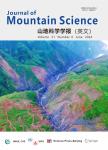Estimation of soil reinforcement by the roots of four postdam prevailing grass species in the riparian zone of Three Gorges Reservoir, China
Estimation of soil reinforcement by the roots of four postdam prevailing grass species in the riparian zone of Three Gorges Reservoir, China作者机构:Key Laboratory of Mountain Surface Processes and Ecological RegulationInstitute of Mountain Hazards and EnvironmentChinese Academy of SciencesChengdu 610041China University of Chinese Academy of SciencesBeijing 100049China State Key Laboratory of Urban and Regional EcologyResearch Center for Eco-environmental SciencesChinese Academy of SciencesBeijing 100085China
出 版 物:《Journal of Mountain Science》 (山地科学学报(英文))
年 卷 期:2016年第13卷第3期
页 面:508-521页
核心收录:
学科分类:082802[工学-农业水土工程] 090707[农学-水土保持与荒漠化防治] 0907[农学-林学] 08[工学] 0828[工学-农业工程] 09[农学] 0815[工学-水利工程]
基 金:Financial support for this study was jointly provided by the National Natural Science Foundation of China (Grant No. 41201272) the Chinese Academy of Sciences Action-plan for West Development (Grant No. KZCX2-XB3-09) the Chinese Academy of Science (Light of West China Program)
主 题:Bank stabilization Root area ratio Root tensile strength Soil reinforcement Riparian zone Three Gorges Reservoir
摘 要:Soil erosion and bank degradation is a major post-dam concern regarding the riparian zone of the Three Gorges Reservoir. The development and succession of vegetation is a main countermeasure,especially to enhance bank stability and mitigate soil erosion by the root system. In this study, the roots of four prevailing grass species, namely, Cynodon dactylon, Hemarthria altissima, Hemarthria compressa, and Paspalum paspaloides, in the riparian zone were investigated in relation to additional soil cohesion. Roots were sampled using a single root auger. Root length density(RLD) and root area ratio(RAR) were measured by using the Win RHIZO image analysis system. Root tensile strength(TR) was performed using a manualdynamometer, and the soil reinforcement caused by the roots was estimated using the simple Wu's perpendicular model. Results showed that RLD values of the studied species ranged from 0.24 cm/cm3 to20.89 cm/cm3 at different soil layers, and RLD were significantly greater at 0–10 cm depth in comparison to the deeper soil layers(>10 cm). RAR measurements revealed that on average 0.21% of the reference soil area was occupied by grass roots for all the investigated species. The measured root tensile strength was the highest for P. paspaloides(62.26MPa) followed by C. dactylon(51.49 MPa), ***(50.66 MPa), and H. altissima(48.81MPa). Nevertheless, the estimated maximum root reinforcement in this investigation was 22.5 k Pa for *** followed by H. compressa(21.1 k Pa), ***(19.5 k Pa), and C. dactylon(15.4 k Pa) at0–5 cm depth soil layer. The root cohesion values estimated for all species were generally distributed at the 0–10 cm depth and decreased with the increment of soil depth. The higher root cohesion associated with H. altissima and H. compressa implies their suitability for revegetation purposes to strengthen the shallow soil in the riparian zone of the Three Gorges Reservoir. Although the soil reinforcement induced by roots is only as



